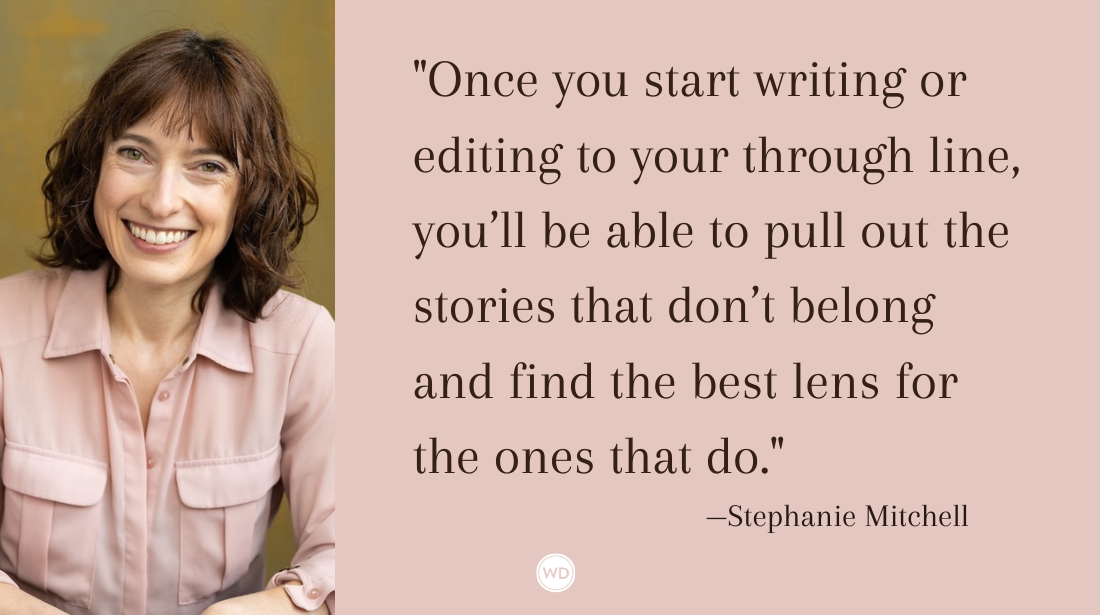How to Write About Family in a Memoir
To write honestly and compassionately about members of your family, you must first reflect on your purpose, your approach, the details of your story and the potential reactions your family members might have. Here’s how to do that.
There is no more potentially contentious group than family. Holidays spent with family members inevitably bring stress. Visits from parents prompt us to unlock the liquor cabinet. And, as memoirists, when we sit down to write the stories of our families—our childhoods, our relationships with parents and siblings, and so on—we often pause, our fingers both itchy and hesitant. Questions begin to stir. What will happen if I write about my family? How will my mom react? Or my brother? Should I tell the truth unflinchingly, or should I take care to write more gently—and less controversially?
To write honestly and compassionately about members of your family, you must first reflect on your purpose, your approach, the details of your story and the potential reactions your family members might have.
This guest post is excerpted from The Truth of Memoir by Kerry Cohen, with permission from Writer’s Digest Books. Kerry Cohen is a psychotherapist, writing faculty at The Red Earth Low-Residency MFA, and the author of Loose Girl, Dirty Little Secrets, Seeing Ezra; and the young adult novels Easy, The Good Girl, and It’s Not You, It’s Me. She lives with the author James Bernard Frost and their four children in Portland, Oregon.
Know Your Purpose
All memoir writing should have layered purposes. If you are writing about your relationship with your complicated mother, you might be writing about how we raise girls in the 21st century. If you write about struggling with obesity and growing up next to your stick-thin sister, you might also be writing about how our culture contributes to people’s struggles with weight.
Consider the classic family memoir The Liars’ Club by Mary Karr. While Karr’s book is about growing up with her wildly eccentric and, at times, disturbing parents, it is much more so about storytelling itself. The Liars’ Club is a group of men, including Karr’s father, who meet at the bar to exchange stories. The stories are rarely true, and through Karr’s experience with the club, she learns that storytelling has the power to save her from her family’s truths. In the end, Karr crafted a book that is as much about how to tell a story as it is about the actual story.
You also should examine your motivations for writing the memoir. Is it to reveal someone for the liar she is? Is it to prove your side of the story? Never write in order to get revenge or to hurt someone. Write only to understand. Perhaps Anne Lamott is right that if people didn’t want to be written about, they should have behaved better, but that doesn’t mean you should behave badly, too. Your objective is to grasp why people behaved the way they did, what their actions or words actually meant.
Write With Compassion
Whether you are writing about your parents or your sister or your great uncle, you must always strive to write with compassion. But what does this mean?
Writing about others with compassion means writing about them as whole people. [Like this quote? Click here to Tweet it!] Your parents are not only the people who did those crappy things to you when you were 10 years old. They are also people who were once children themselves, who also had parents who may or may not have done crappy things to them. Maybe one grew up in a Detroit ghetto and had to share a can of beans with three other siblings for dinner every night. Or maybe the other grew up in a time when women were treated like possessions. Or maybe no one ever talked to either of them about sex when they were teens, or they were bullied as children, or they had to learn to speak English in a strange, unforgiving country.
The point is that your parents are also people. They are human beings whose life events informed who they became. And all human beings, including you and me, are flawed and limited as well as wonderful and unique. No one is exactly like anyone else.
This doesn’t mean you have to address the entire context surrounding a person in your book or essay, but it does mean that you should take the time to know more about who that person is. You can do this in a number of ways. The most obvious is to interview that person or the people who know her.
But even if you can’t find out about a person’s background, try to see the person’s context as you explore your experience or memory of her. Notice gestures that reveal vulnerability, insecurity or other feelings behind her actions. Does your mother keep checking herself in the mirror? Does she constantly rearrange the silverware on the table? Does your friend say, “I’m so happy for you,” but her smile is too big, disproportionate to the situation? Does your wife answer your questions about where she’s been all night, but keep her back to you while she speaks? Notice the humanness of the person—and include it when you write.
In the middle of writing your memoir or thinking about writing it?
WD’s Memoir Writing Kit is 6 items rolled into one bundle
at a steep discount. This kit gives simple, yet in-depth instruction
on crafting a great memoir and getting it published.
Order now from our shop and get the huge discount.
Share Your Work Wisely
Family members aren’t always going to love your memories of what they’ve said or done, and many writers want to know if they should show their manuscripts to the people they wrote about.
Most writers would agree that it isn’t a good idea to share what you’re writing until you’re finished. The writing process is sacred, almost magical. Introducing anyone else’s voice into your process is rarely a good choice for the work. Once the story is written, though, some memoir writers do choose to let their family members read it. Before she publishes a work, Hope Edelman asks certain family members she has written for feedback about passages relating to them and sometimes offers veto power. “This often improves a piece and sometimes leads to conversations we need to have on a personal level,” she says.
But memorist Abby Mims has very different advice. She says, “Never show anyone something you’ve written about them, before or after publication.” In other words, don’t go out of your way to let them know you wrote about them. They’ll find out, or they won’t.
Ultimately you must decide whether to show the story and to whom you show it on a case-by-case basis. I gave my sister the manuscript for my memoir Loose Girl to read before it went to copyediting because I’d written about her throughout the book, and I wanted to respect her experience of becoming one of my subjects. I trusted that she understood my intentions—that it was the story of my experience growing up in our family, not hers. Indeed, that’s exactly how she responded. She was sad to read about my struggle, even if she viewed herself very differently. But she understood that if she wanted to show her reality, her perspective, she’d have to write her own memoir.
Prepare For Reactions
People who set out to write a memoir about their families are often terrified of the possible repercussions. What will Mom do when I expose her as an alcoholic? What will my brother think of me once I tell what really happened between us? How will Grandma react to my feelings about her? These are real, frightening questions, and they keep many people paralyzed at their keyboards, unable to write a word.
Sue William Silverman offers this advice: “I never allowed concerns to stand in the way of writing. I’ve always felt that as a writer of memoir, I own my truth and I am free to write about it.”
We can’t know how family members will react to the exposure of painful secrets or unspoken truths, but most memoirists would agree that you can’t predict what will happen, who will feel good or bad about the revelations in your work, and why. I thought one of my memoirs served as a sort of apology to someone, and that person is one of the people who couldn’t forgive me for writing it. I was terrified about how my mother would respond, and she’s been one of my greatest supporters. We can’t know, or control, what happens. The key, then, is to write. Just write, and prepare for potential responses, good or bad.
Sometimes family members will be upset by the words you write. This happened to Jillian Lauren after her memoir Some Girls:My Life in a Harem was published. She says, “The biggest sadness was my parents’ reaction to the memoir. I had hoped they would be able to be supportive, but I was also prepared for them to have a negative reaction. When the book came out, they were hurt and angry and they opted to no longer have any contact with me.”
But family members’ reactions aren’t always negative. In fact, positive changes in relationships are just as likely. Kim Barnes, whose father had shunned her before she wrote In the Wilderness, was sure that he’d do so again and that her kids would lose their grandparents. When her parents responded instead with acceptance and forgiveness, it opened the door to long conversations and an increased understanding of their relationship. “What I know now is that by allowing yourself to be vulnerable and flawed and compassionate, other people feel the desire to do the same thing. … We cannot underestimate the love and permission that our families will give us if we believe in what we’re doing for the right reasons.”
Honesty. Compassion. Forgiveness. Hold these words in your mind as you write about your family. Allow them to pulse through the pages of your memoir. Know that you can’t presuppose how your family members will react to your writing about them, but if you keep these precepts in mind, you will reduce your chances of hurting or angering them. Your memoir or essay may even be the key that opens the door to communication, reflection and a better understanding of your family and your place within it.
Thanks for visiting The Writer's Dig blog. For more great writing advice, click here.
Brian A. Klems is the editor of this blog, online editor of Writer's Digest and author of the popular gift bookOh Boy, You're Having a Girl: A Dad's Survival Guide to Raising Daughters.
Follow Brian on Twitter: @BrianKlems
Sign up for Brian's free Writer's Digest eNewsletter: WD Newsletter









